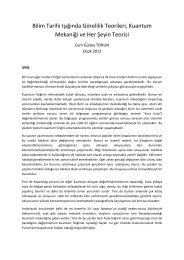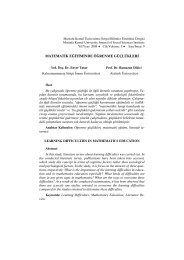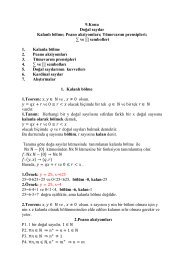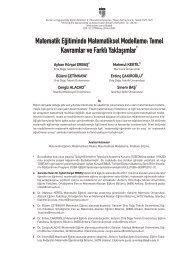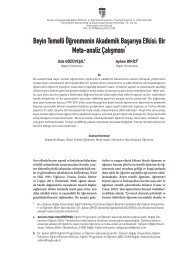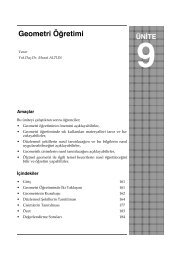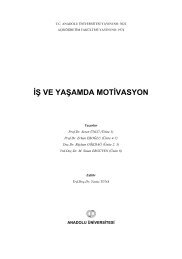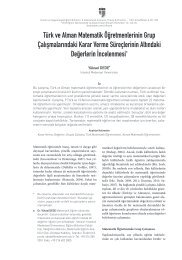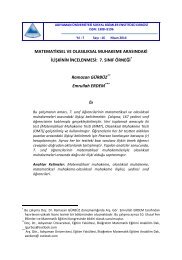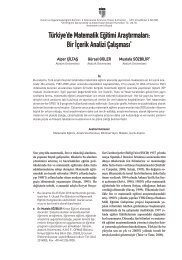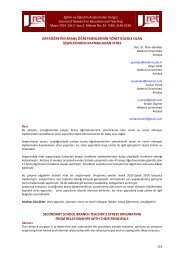After reviewing the related literature, examining the studies carried out in the field, andinterviewing a focus group of 10 students; the content and items to be included in thequestionnaire were determined. The questionnaire was pilot tested for this particular study;and its revised version was implemented in the study. The piloted and revised version of thequestionnaire, which was the main instrument of this study, was composed of three sections.(See Appendices A1 and A2)According to Woolley (2009) qualitative and quantitative data complement each other well.Therefore, after the administration of the questionnaire, a semi-structured student interviewguide (See Appendices B1 and B2) including 3 questions and a semi-structured academicinterview including 4 questions were prepared (See Appendices C1 and C2). These interviewswere used as the second data collection tool with the purpose of gathering more detailed data;and by all means the aim of each question within the interview was to complement theinterpretation of the data gathered through the questionnaire.3.3. Data Collection ProcedureThe data were gathered through a questionnaire, a semi-structured student interview, and asemi-structured academics interview during the spring semester in 2012-2013 academic year.The questionnaire was administered to a total of 256 freshman students studying at variouspartly English-medium departments at the Faculty of Architecture, the Faculty ofEngineering, the Faculty of Sciences, and the Faculty of Economics and AdministrativeSciences. The students were asked to complete the questionnaires in their classes during theclass hours.The interviews with 12 volunteer students and 2 academics were held at a predetermined dateand time at the above-mentioned faculties. In order for the participants to comment on thequestions comfortably, the interviews were held in Turkish. All interviews were recorded andtranscribed by the researchers to be used in data analysis phase.3.4. Data AnalysisAs mentioned before, this study adopts both qualitative and quantitative research methods.Hence, at data analysis stage, the researchers dealt with the raw data in two phases:quantitative analysis of the data gathered through questionnaires, and qualitative analysis ofthe data obtained through interviews. Finally, quantitative and qualitative data were combinedto be discussed in detail.4. RESULTS AND DISCUSSION4.1. General Background of the StudentsAs revealed in the previous part, all of the students having involved in the study (f= 256, 100%) were freshman students and ranged in age from 18 years to 25 years. Of the students 145(56.6%) were males and 111 (43.4 %) were females. The frequency and the percentage of thestudents enrolled at the Faculty of Architecture (Architecture, Urban and Regional Planning,and Industrial Product Design), the Faculty of Engineering (Chemical Engineering, CivilEngineering, Computer Engineering, Electrical-Electronics Engineering, IndustrialEngineering and Mechanical Engineering), the Faculty of Sciences (Statistics) and the Facultyof Economics and Administrative Sciences (Business Administration, Public Administration, 12
International Relations) were 20 (7.8 %), 104 (40.6 %), 30 (11.7 %), 102 (39.9 %)respectively.All the students who took part in the study (f=256, 100 %) reported having studied at thePreparatory School for a year. When the students were requested to provide informationabout the two skills that they assumed they developed most in the Preparatory School, 107(41.8 %) of them selected "reading and writing", 51 (19.9 %) of them selected "reading andlistening", 44 (17.2 %) chose "reading and speaking", 32 (12.5 %) of them chose "writing andlistening", 18 (7 %) of them selected "writing and speaking", and only 4 (1.6 %) of themchose "listening and speaking".The students were also expected to order the given language skills from the most important(1) to the least important (4) in terms of their current needs and success in their departments.While 29.3% of the students said that "listening" is the most needed language skill, 27.1 % ofthem confirmed that "speaking" is the most needed. "Reading", on the other hand was chosenthe most needed skill by 24.2 % of the students; and "writing" was chosen the most neededskill by only 19.4 % of them. In conclusion, the students' responses to the last item in the firstsection of the questionnaire showed that the students had taken at least 2 and at most 6English-medium content courses in their departments until then.4.2. Comparison of the Students’ Language Needs and CompetenciesIn order to assess the adequacy of the program and to classify the extent to which their needshave been met, the students' language needs and competencies in their English-mediumcontent courses were compared.Referring to the results of the study, it might be assumed that there are critical differencesbetween many of the students' language needs and perceived competencies. Accordingly,while the students often need to take notes, they can partly accomplish this. Similarly, thestudents often need to get specific information while listening to a lecture; however, theycould partly satisfy this need. The results may also reveal that the students often need topredict unknown words while listening to a lecture; however, they do not feel capable ofmeeting this need. The students often need to answer questions asked by the lecturer; yet theycan partly fulfill this. Likewise, the students often need to ask questions to the lecturer;however, they reported being partly competent in this. While the students often need toparticipate in discussions during a lecture, they can partly satisfy this need. Moreover, thestudents' need for retelling a text they read in their own words was not satisfied, either. Thereis also an important difference between the students' need for guessing unfamiliar wordswhile reading a text and their competence in doing this. The students' need for translatingtexts by using a dictionary and their competence in meeting this need did not overlap, either.Lastly and surprisingly, the students said that they sometimes or need to write short notes, e-mails in informal language; however, they can satisfy this need very well.Accordingly, the results may show that the students' needs are centered on listening andspeaking skills, as well as, vocabulary. It can be said that these results show a similarity withthe findings of a needs assessment study on English language needs of the Tour Guidancestudents of the Faculty of Applied Sciences at Başkent University conducted by Ekici (2003).Moreover, the results might also indicate that the students need translation skills within theirdepartmental studies, which to some extent corresponds to Alagözlü's study (1994) carried outat the Faculty of Medicine in Cumhuriyet University with the purpose of revealing theEnglish language skill needs of fourth year Medical students. 13
- Page 1 and 2: ISSN: 2146-7676UFUK ÜNİVERSİTES
- Page 3 and 4: UFUK ÜNİVERSİTESİSOSYAL BİLİM
- Page 5 and 6: SUNUŞDergimizin 2014 yılı ilk sa
- Page 7 and 8: A NEED-BASED EVALUATIONOF A PREPARA
- Page 9 and 10: In the literature on language teach
- Page 11: focus teaching on this. Accordingly
- Page 16 and 17: questionnaire in their English-medi
- Page 18 and 19: REFERENCESAlagözlü, N. K. (1984).
- Page 20 and 21: APPENDIX A1 STUDENT QUESTIONNAIRE
- Page 23 and 24: 24. Converting short notes into
- Page 27 and 28: The Role Of Gender On University St
- Page 29 and 30: (Johnson 2001; Türküm, 2005). Joh
- Page 31 and 32: Table 1 : Means and Standard Deviat
- Page 33 and 34: 2.3 ProcedureEthical permission to
- Page 35 and 36: age and attitude toward help seekin
- Page 37 and 38: Economics and Administrative Scienc
- Page 39 and 40: REFERENCESAddis, M. E., & Mahalik,
- Page 41 and 42: Koydemir-Özden, S. (2010). Self-as
- Page 43 and 44: LİSE ÖĞRENCİLERİNİN MESLEKİ
- Page 45 and 46: göre mesleki bakımdan daha önce
- Page 47 and 48: Araştırmanın amacıMesleki olgun
- Page 49 and 50: Tablo 1: Lise Öğrencilerinin Mesl
- Page 51 and 52: Lise öğrencilerinin karar verme s
- Page 53 and 54: KAYNAKÇA Acıbozlar, Ö. (2006). Y
- Page 55: Oğuz, Ö. (2008). Lise öğrencile
- Page 58 and 59: 1. IntroductionDifferent from the p
- Page 60 and 61: noteworthy to mention that multilin
- Page 62 and 63:
The findings indicate that multilin
- Page 64 and 65:
Table 1. Descriptives statistics fo
- Page 66 and 67:
overall six factor structure which
- Page 68 and 69:
wider variety of strategies with a
- Page 70 and 71:
inclusion of instructors who are no
- Page 72 and 73:
Gardner, R. C., & MacIntyre, P. D.
- Page 74 and 75:
AppendicesAppendix A- English Profi
- Page 77 and 78:
ELT Student Teachers’ Evaluations
- Page 79 and 80:
Reflective Teaching in TurkeyIn Tur
- Page 81 and 82:
Table 1: Reliability Analysis o
- Page 83 and 84:
Table 4: Mean and standard dev
- Page 85 and 86:
Table 9: Mean and standard dev
- Page 87 and 88:
ReferencesAkbari, R. (2007). Reflec
- Page 89:
Pollard, A. & Triggs, P. (1997) Ref
- Page 92 and 93:
1. GİRİŞEğitim ve program geli
- Page 94 and 95:
Genelgeçer tek bir bilimsel sürec
- Page 96 and 97:
Program geliştirmedeki yenilikleri
- Page 98 and 99:
-Elde ettiği sonuçlardan hareket
- Page 100 and 101:
“İnternet Üzerinden Öğrenme
- Page 102 and 103:
de sınıf içi dersler de öğrenm
- Page 104 and 105:
teknik ve pedagojik uzmanlar gerekt
- Page 106 and 107:
3. Proje ekibinin kurulması4. Plan
- Page 108 and 109:
KAYNAKÇABigdoli, H. (2004). The In
- Page 110 and 111:
110
- Page 112 and 113:
Hiçbir öğrenci bir diğeriyle ay
- Page 114 and 115:
İçerik sınıfta nelerin öğreti
- Page 116 and 117:
(MEB, 2006; Tomlinson, 2005). Ek ol
- Page 118 and 119:
- Öğrencilerden gereksinim duyduk
- Page 120 and 121:
desteklerine gereksinim duydukları
- Page 122 and 123:
KAYNAKÇAAlberto P. A, ve Troutman
- Page 124 and 125:
124
- Page 126 and 127:
1.GİRİŞBuradaki araştırma OECD
- Page 128 and 129:
öğretilenleri almışlar mı diye
- Page 130 and 131:
edileceğini araştırmaz, ancak bu
- Page 132 and 133:
yaşarlar: Çok fazla sayıda koşu
- Page 134 and 135:
• Birincil Stratejiler ve Destek
- Page 136 and 137:
ir dönemdir. Özellikle artan yaş
- Page 138 and 139:
2. Hipotez: Öğretmenlerin coğraf
- Page 140 and 141:
Tablo 7 Öğretmenlerin Coğrafi
- Page 142 and 143:
stratejileri”ne yönelik bilişse
- Page 144 and 145:
sonuçları χ 2 (12, N =407) = 13,
- Page 146 and 147:
sebebiyet verir. Bunun önemli bir
- Page 148 and 149:
KAYNAKÇAArtelt, C., Stanat, P., Sc
- Page 150 and 151:
Lieteratur. 10. Sonderheft: Lesesoz
- Page 152 and 153:
YAYIM ALANI, YAZIM KURALLARI ve YAZ
- Page 154:
• Birebir alımlar “…” İş





